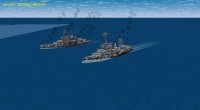
America Alone
|
A hypothetical Scenario. Summer of 1941: After the successful invasion of Britain in Autumn of 1940 - Operation Sealion - the British forces surrendered in spring of 1941. The remaining ships of the Royal Navy were integrated into the German Kriegsmarine which had to challenge another enemy: Take out the US Atlantic Fleet in a decisive battle.
|
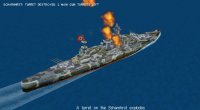
by Michael Emmerich
|

Battle of Badung Straight
|
An ABDA flotilla moves to intercept an IJN invasion force off the island of Bali in an ill-planned two element strike.
The first wave, led by Dutch cruisers De Ruyter and Java, struck with little effect several hours earlier, and disengaged from the area. The second wave of ABDA forces arrives at about 01:30 in the morning of February 19, 1942.
Designer's notes: RN Arethusa fills in for the Dutch CL Tromp, modified with the removal of the secondary 4" guns to more closely reflect the Dutch cruiser's armament. Starting positions of some IJN units are closer than historical for playability.
|
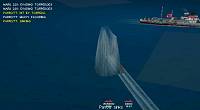
by Brian Thomas
|
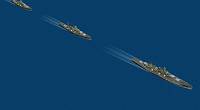
Battleline in the North Atlantic
|
In early 1942, German U-Boats were sinking Allied merchant tonnage faster than new ships could come off the ways. The destruction of the US Navy's Pacific fleet battleline forced the US to transfer as much sea power as possible to the Pacific to guard the West Coast. Britain's Royal Navy was stretched paper thin protecting convoys and keeping track of Germany's surface vessels. The time is right for the Kriegsmarine to break out in force and do as much damage as possible. The US Navy has put together a patchwork force of destroyers, cruisers and battleships to stop the Kriegsmarine.
|
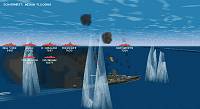
by Philip C. Cockrell
|
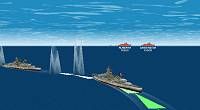
Battlewagon
|
In May, 1941 the KM Bismarck engaged two British battleships, sinking one and damaging the other. But how would it have fared against the USN? In this hypothetical scenario, the Tirpitz, along with the CA Admiral Hipper, engages the USS Alabama and the USS Washington.
|

by Robert Schoneman
|
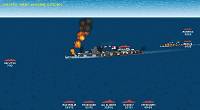
Big One (Hypothetical)
|
A hypothetical engagement in the North Atlantic: A major German battlegroup is detected and the British home fleet is sent out to sink the enemy.
|

by Peter Vandesande
|

Destruction in the Biskay
|
On 28.12.1943 the German destroyer Z27 and the Flottentorpedoboote T25 and T26 were sent into the Biskay to escort the blockade breaker Alsterufer into a French port. But this operation had no happy end. The German warships were intercepted by the British CLs Glasgow and Enterprise and in an single sided battle, all three German ships were sunk with a huge loss of life.
Note: This scenario requires an updated DataTable file which is included in the ZIP-file. It replaces the Zerstörer 1934A destroyer with the Flottentorpedoboot 1939. Please read the README.TXT file first!
|
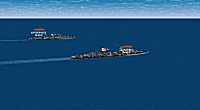
by Michael Emmerich
|
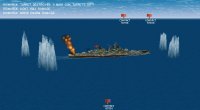
Bismarck's final battle
|
After a long hunt, the Bismarck finally saw its final battle on May 27th 1941. Crippled by a torpedo hit the previous day, the German battleship was waiting for the arrival of several British warships and to fight the its ultimate battle. After 90 minutes of intensive gun fire from close range, the Bismarck sunk in the cold waters of the North Atlantic.
|
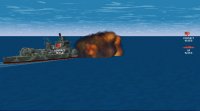
by Michael Emmerich
|
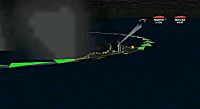
Brave Bremse
|
The Bremse was a artillery training ship - similar to a torpedo boat or a small destroyer. In September 1941, the Bremse was escorting two German transports through Norwegian waters when the small convoy was attacked by two British CLs. Night, fog and bad visibility was a problem for both sides but the odds were against the Germans. The little Bremse was able to cover the the transports and they escaped into the fog while the artillery training ship was destroyed at close range by the guns of the British CLs.
|
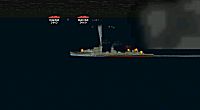
by Michael Emmerich
|
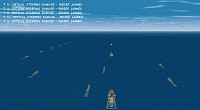
Cerberus
|
February 1942: After months of permanent British air attack in Brest, two German BBs (Gneisenau and Scharnhorst) and one CA (Prinz Eugen) make a spectacular and successful attempt to break through the narrow English channel, reaching the North Sea. Only the artillery near Dover, some smaller ships - mainly 5 old DDs (here represented by BB & USN-4-pipers) and a few brave British pilots try to interfere.
Fast PC required, optimized for FSP.
|
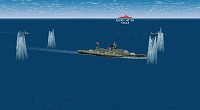
by Bz
|

Convoy WS5A
|
In December 1940, the German CA Admiral Hipper made its first Atlantic operation called "Nordseetour".
On December 24th 1940 the Admiral Hipper sighted a convoy on the shipping route to Sierra Leone. Shadowing the allied ships during the night, the German cruiser closed in the early morning, just to see that it was a heavily defended convoy of troop transports, the WS5A. During the following battle, Hipper was able to damage the British CA Berwick, but had to disengage because of the heavy British convoy escort and engine problems.
|
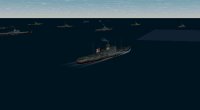
by Michael Emmerich
|
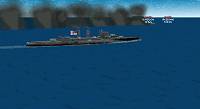
Demise of the Exeter
|
An outnumbered ABDA force flees from IJN surface groups in this historical but one-sided daylight action fought in the Java Sea south of Borneo on March 1, 1942.
Designer's notes: This scenario is tough to win as the Allied player, and a victory point modifier is given to help "balance" the scenario. Exeter starts with moderate propulsion system damage to reflect a hit taken during the earlier Battle of the Java Sea.
|

by Brian Thomas
|
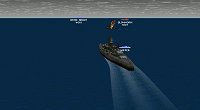
Destruction of the Glowworm
|
In April 1940, the German Kriegsmarine started Operation Weserübung , the invasion on Norway. On its way north, the German ships sailed through a heavy storm when one of the destroyers, the Bernd von Arnim detected a lone British destroyer. It was the Glowworm , searching for a man that went over board. The soon arrived CA Admiral Hipper was no match for the British ship and both captains had the idea to ram the enemy. The Glowworm finally raced out of a cloud, close to the Admiral Hipper and rammed the cruiser at its bow, causing a 40 meter long hole in the hull. although damaged, the cruisers could continue its mission but the brave Glowworm was sunk, only 38 British sailors could be rescued by the German ships.
|

by Michael Emmerich
|

Battle of the Java Sea
|
On February 27th 1942, an allied force under the command of Admiral Doorman attacked the cover group of a Japanese Troop transport. In the following battle, two Dutch cruisers and three destroyers were sunk, while the Japanese only had minor damages. Most of the surviving allied ships are sunk in various battles the next day.
|

by Grant Michaud
|
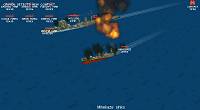
Convoy Action
|
A Japanese convoy heading to bases in the south is intercepted by an escort force on it's way to meet up with a carrier task force. The Yanks have at it! ALERT!!: The convoy was spotted by a PBY north west of your pos. They are proceeding on a heading of 220 degrees, speed 8 knots. We suggest a course of 270 degrees, all ahead flank! Turn off limited course chgs.
|
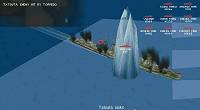
by Otto Freischer
|





























